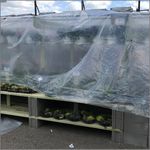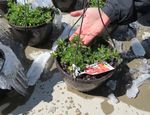Don't Let Unpredicatble Weather Nip your Crops in the Garden Center - e-GRO
←
→
Page content transcription
If your browser does not render page correctly, please read the page content below
Roberto G. Lopez
rglopez@msu.edu
Volume 10 Number 19 April 2021
Don’t Let Unpredicatble Weather 2021 Sponsors
Nip your Crops in the Garden Center
The pandemic, coupled with the cold winter has consumers
demanding annuals, herb, and vegetable transplants weeks
before the last average frost date. As growers, you obviously
want to cash in and take advantage of these impulse
purchases. But we all know this is risky! What can you do to
prevent losses during those unpredictable cold snaps that
occur in April and even into May? In this alert, we will provide
some tips on how to protect your crops and provide you with a
list of cold hardy plants you should be selling.
The above normal and record breaking temperatures this past
March has consumers visiting garden centers in search of
anything to plant in their garden. These means that un-
acclimated plants could be sitting on outdoor garden center
benches, on a flat bed trailer or wagon in front of your
greenhouse.
When should you be concerned about these crops and what can
you do to protect them from injury or death as cold
temperatures will inevitably return? What does it mean when
the weather forecast say there is a “frost” and “freeze”
warning or watch?
Reprint with permission from the
Figure 1. Chilling injury on celosia after author(s) of this e-GRO Alert.
one night in the garden center when the
temperatures dropped down to 35 ºF (1.7
ºC) for a few hours. Photo credit: Roberto
Lopez
www.e-gro.org
1e-GRO Alert - 2021 Preventing Chilling and Freezing Injury in the Garden Center
Frost advisories are only issued under
atmospheric conditions that will likely
lead to a frost. These include a
combination of a thermal inversion where
temperatures near the ground surface
drop, while warmer air develops above,
winds are calm, and the sky is clear.
During a frost advisory, temperatures are
≤36 ºF (≤2.2 ºC). On the other hand,
freeze and hard freeze warnings are only
issued when air temperatures are
expected to be between 29 to 32 ºF (-1.6
Figure 2. Chilling injury (desiccated areas on leaves
to 0 ºC) or ≤28 ºF (-2.2 ºC), respectively. that appear like water spots) on an unprotected
Freezes occur when winds are above 5 impatiens crop (cold sensitive crop) in a garden center
mph and a cold air mass moves into an a day after a frost advisory. Photo credit: Roberto
Lopez
area bringing temperatures below 32ºF. A
freeze/ hard freeze watch may be issued
a few days ahead of time if the potential
exists for temperatures to fall.
What is Freezing injury?
Freezing injury is damage that occurs to
plant tissues when temperatures are
below 32 ºF. Pure water freezes at 32 ºF,
however, water in plant tissue has
dissolved salts (ex. plant sap), which
freezes at temperatures a few degrees
below 32 ºF. If water freezes in a plant
cell, the sharp ice crystals can cut cell Figure 3. Chilling injury on wax begonia appearing as
membranes, resulting in fluids leaking necrotic speckled lesions on leaves and flowers. Plants
were in the parking lot of a big box store. Photo credit:
from the cell, leading to cell and plant Roberto Lopez
death. Freezing injury symptoms include
tissue browning, dark green foliage that
then appears water soaked, blackening,
wilting or curling of leaves and stems.
Young plant tissue is more vulnerable to
freezing than mature tissue. The cold
tolerance of hardy and frost tolerant crops
to freezing temperatures increases as the
plants are gradually acclimated to cooler
temperatures over time. In other words, a
cold hardy plant grown in a warm (heated)
greenhouse is more susceptible to freezing
injury in the garden center than one that
has been in a cold frame, high tunnel, Figure 4. Symptoms of chilling injury on cold tolerant
cilantro that was not acclimated and placed in a garden
unheated structure, or outdoors. center. Photo credit: Roberto Lopez
www.e-gro.org 2e-GRO Alert - 2021 Preventing Chilling and Freezing Injury in the Garden Center
Figure 5. Freezing injury on cold sensitive coleus after Figure 6. Exposure to temperatures around 35 ºF in
exposure to near freezing temperatures. Photo credit: early May caused severe chilling injury on tomato
Roberto Lopez leaves that appear as brown speckling. Photo credit:
Roberto Lopez
What is Chilling Injury?
Chilling injury is a form of cold damage (with similar symptoms to freezing injury) that
occurs to certain plants when exposed to non-freezing temperatures (Figures 1 to 6).
Depending on the plant, chilling injury can occur at temperatures from 32 to 55 ºF (0 to
10 ºC). Plants from tropical origins are often chilling-sensitive, while most temperate
zone species are not if they have been properly acclimated to cold temperatures (Figure
4).
How can you Protect Crops on those Cold Nights?
You can reduce convective heat loss from the surface of crops and trap radiant heat
during the day by carefully placing frost blankets, floating row covers (ie. Reemay cloth),
straw, tar paper, or plastic above crop (Figures 7 and 8). Make sure plastics do not
directly touch the crops as this can lead conductive heat loss.
An irrigation system or overhead sprinkler can be used to apply a very low rate of water
to form a continuous film of water on crop foliage to prevent freeze damage (Figure 9).
The principle behind this practice is that as water cools, it gives off heat until the
temperature of the water is 32 ºF (0 ºC). This ultimately results in preventing the
temperature of the plant from falling below 31.5 ºF (-0.3 ºC). During this process, a layer
of ice forms on the leaves (Figure 9). This method used by orchards can protect plants
from temperatures as low as 21 ºF (-6 ºC). The application of water should begin as soon
as temperatures are right near freezing and a film of water needs to be maintained until
temperatures have risen above freezing. If you prematurely discontinue sprinkling or
equipment fails, evaporative cooling will draw heat from leaves as the ice melts and
damage can occur. Additionally, if the freezing temperatures last for a long period of
time, a thick layer of ice may form on leaves and branches (Figure 9). Upon melting
plants should not be injured (Figure 10).
If you are not a risk taker, plants can be brought into a heated barn, hoop house or other
structure until temperature are above freezing.
www.e-gro.org 3e-GRO Alert - 2021 Preventing Chilling and Freezing Injury in the Garden Center
Know the Cold Tolerance of the Crops you Grow
Make your customers successful gardeners by only producing and selling crops that can
tolerate the “average” conditions of where they will be sold and take the average frost-
free date into consideration. Table 1 contains the general cold hardiness of several
popular annuals, herbs, and vegetables that have been acclimated.
Table 1. Cold Tolerance of Acclimated Vegetables and Ornamentals
Hardy/ Cold-tolerant Frost Tolerant Tender Cold-sensitive
Alyssum Ageratum Aster Alternanthera
Asparagus Broccoli Geranium Angelonia
Bidens Brussels sprout Nicotinia Basil
Calibrachoa Bells of Ireland Scabiosa Begonia
Cilantro Cabbage Statice Celosia
Collard greens Cauliflower Snap bean Cleome
Diascia Calandula (pot marigold) Sweet corn Coleus
Forget me not Coreopsis Verbena Cosmos
Kale Chard Cucumber
Lettuce Chinese cabbage Eggplant
Nasturtium Cyclamen Impatiens
Nemesia Dianthus Ipomoea (sweet potato vine)
Ornamental cabbage & kale Dusty Miller Lantana
Parsley Dutch bulbs Marigold
Pansy Lobelia New Guinea impatiens
Pea Osteospermum Peppers
Potato Petunia Portulaca
Primrose Pocketbook plant Salvia
Ranunculus Rudbeckia Sunflower
Rhubarb Snapdragon Watermelon
Spinach Sweet pea Vinca
Sugar snap pea Zinnia
Stock
Hardy/ cold tolerant crops can withstand short periods of freezing temperatures and hard frosts without injury.
They may be planted 4 to 6 weeks before the average frost free date.
Frost tolerant crops can withstand light frosts and can be planted 2 to 3 weeks before the average frost free date.
Tender crops are injured or killed by frost and should be planted on or after the average frost-free date.
Cold-sensitive crops cannot tolerate prolonged exposure to temperatures below 50 ºF. They should be planted 1
to 2 weeks after the average frost-free date.
www.e-gro.org 4e-GRO Alert - 2021 Preventing Chilling and Freezing Injury in the Garden Center
Even though cole /brassica crops ie.
cabbage, broccoli, and cauliflower) are
considered frost tolerant, young plants
exposed to cold temperatures will respond
by bolting (producing a flowering stalk).
Therefore, these crops should not be
exposed to several days of temperatures
below 45 ºF (7 ºC) when the stem is
smaller than the width of a pencil. Bolted
plants should be discarded.
Figure 7. This garden center is covering their crop with a
frost cover as the temperatures are forecast to reach 32 ºF.
Photo credit: Roberto Lopez
Figure 8. A big box store attempting to protect the
plants in their garden center with clear plastic
prior to freezing temperature. Photo credit:
Roberto Lopez
Figure 9. This grower started sprinkling when the lowest
observed leaf or flower temperature was 32 ºF. Photo credit:
Royal Heins
Figure 10 (left). Once the ice melted, the calibrachoa crop
survived and was uninjured after exposure to temperatures
in the low 20’s for several hours. Photo credit: Royal Heins
www.e-gro.org 5e-GRO Alert - 2021
e-GRO Alert Cooperating Universities
www.e-gro.org
CONTRIBUTORS
Dr. Nora Catlin
Floriculture Specialist
Cornell Cooperative Extension
Suffolk County
nora.catlin@cornell.edu
Dr. Chris Currey
Assistant Professor of Floriculture
Iowa State University
ccurrey@iastate.edu
Dr. Ryan Dickson
Greenhouse Horticulture and
Controlled-Environment Agriculture
University of Arkansas
ryand@uark.edu
Thomas Ford
Commercial Horticulture Educator
Penn State Extension
tgf2@psu.edu
Dan Gilrein
Entomology Specialist
Cornell Cooperative Extension
Suffolk County
dog1@cornell.edu
Dr. Joyce Latimer
Floriculture Extension & Research
Virginia Tech
jlatime@vt.edu
Heidi Lindberg
Floriculture Extension Educator
Michigan State University
wolleage@anr.msu.edu
Dr. Roberto Lopez
Floriculture Extension & Research
Michigan State University
rglopez@msu.edu
Dr. Neil Mattson
Greenhouse Research & Extension
Cornell University
neil.mattson@cornell.edu
Dr. W. Garrett Owen
Greenhouse Extension & Research
University of Kentucky
wgowen@uky.edu
Dr. Rosa E. Raudales
Greenhouse Extension Specialist
University of Connecticut
rosa.raudales@uconn.edu
In cooperation with our local and state greenhouse organizations
Dr. Beth Scheckelhoff
Extension Educator – GreenhouseSystems
The Ohio State University
scheckelhoff.11@osu.edu
Dr. Ariana Torres-Bravo
Horticulture/ Ag. Economics
Purdue University
torres2@purdue.edu
Dr. Brian Whipker
Floriculture Extension & Research
NC State University
bwhipker@ncsu.edu
Dr. Jean Williams-Woodward
Ornamental Extension Plant Pathologist
University of Georgia
jwoodwar@uga.edu
Copyright © 2021
Where trade names, proprietary products, or specific
equipment are listed, no discrimination is intended and
no endorsement, guarantee or warranty is implied by
the authors, universities or associations.
www.e-gro.org 6You can also read



























































